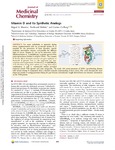Vitamin D and Its Synthetic Analogs

Use este enlace para citar
http://hdl.handle.net/2183/38901
A non ser que se indique outra cousa, a licenza do ítem descríbese como Creative Commons Attribution (CC-BY)License
Coleccións
- Investigación (FCIE) [1234]
Metadatos
Mostrar o rexistro completo do ítemTítulo
Vitamin D and Its Synthetic AnalogsData
2019Cita bibliográfica
Maestro, M. A., Molnár, F., & Carlberg, C. (2019). Vitamin D and its synthetic analogs. Journal of Medicinal Chemistry, 62(15), 6854-6875. https://doi.org/10.1021/ACS.JMEDCHEM.9B00208
Resumo
[Abstract] For many individuals, in particular during winter, supplementation with the secosteroid vitamin D3 is essential for the prevention of bone disorders, muscle weakness, autoimmune diseases, and possibly also different types of cancer. Vitamin D3 acts via its metabolite 1α,25-dihydroxyvitamin D3 [1,25(OH)2D3] as potent agonist of the transcription factor vitamin D receptor (VDR). Thus, vitamin D directly affects chromatin structure and gene regulation at thousands of genomic loci, i.e., the epigenome and transcriptome of its target tissues. Modifications of 1,25(OH)2D3 at its side-chain, A-ring, triene system, or C-ring, alone and in combination, as well as nonsteroidal mimics provided numerous potent VDR agonists and some antagonists. The nearly 150 crystal structures of VDR’s ligand-binding domain with various vitamin D compounds allow a detailed molecular understanding of their action. This review discusses the most important vitamin D analogs presented during the past 10 years and molecular insight derived from new structural information on the VDR protein.
Palabras chave
Modification
Nutrition
Organic compounds
Peptides and proteins
Screening assays
Nutrition
Organic compounds
Peptides and proteins
Screening assays
Versión do editor
Dereitos
Creative Commons Attribution (CC-BY)License






